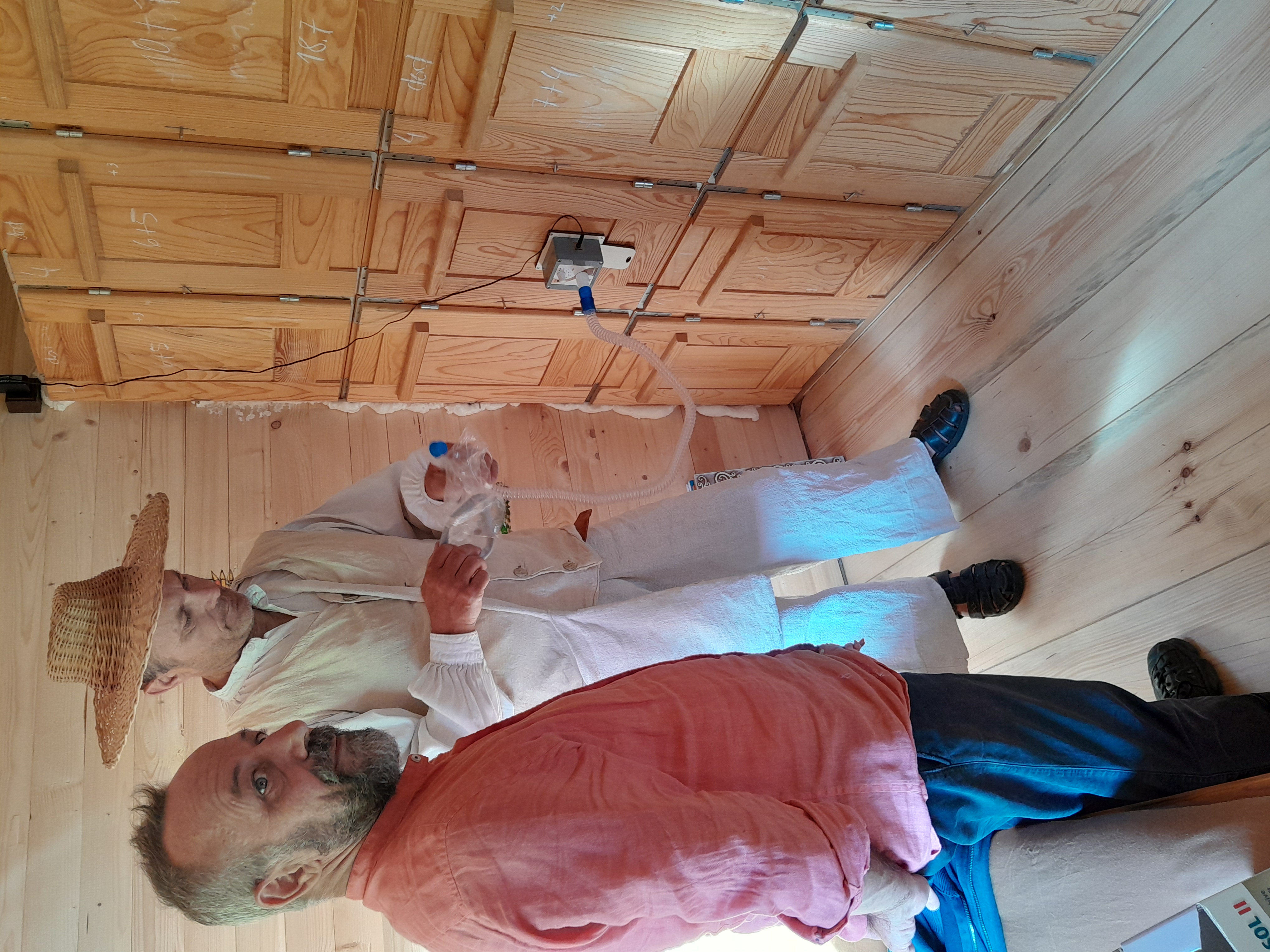I am in Poljčane, North-Eastern Slovenia, approximately 30 km from Maribor, in the middle
of the typical Alpine landscape with steep, forested mountains, Alpine meadows and pastures
on the hillsides, and a dispersed settlement structure. With the partners of the BiodiverCity
URBACT Action Planning Network, focusing on community-based approaches to foster
urban biodiversity and nature-based solutions, I am travelling to a farm on the top of a hill.
Boštjan Jug, the head of the farm and her teenage daughter, Judita Jug welcome us, not with
traditional Slivovica, a plum-based spirit, but with different honey products. Boštjan is in
traditional clothes, while his daughter is in a black farmer and T-shirt with her smartphone in
her hands. Two separate worlds, but with the same passion for apitherapy and the
dissemination of the new beehive therapy. We enter a small presentation room, and the show
starts…
Bee products as medicine
Apitherapy, the use of bee products including honey, pollen, bee bread, propolis, royal jelly,
beeswax, bee venom and larval bees is well known across Europe, especially here, in Central
Europe since it was born in Slovenia. Apitherapy has different meanings and definitions in
other parts of the world, but in Europe, it is known as the use of all mentioned beehive
products.
This complementary therapy has been used for thousands of years: it can be traced back to
ancient Egypt and China, but the Greeks and Romans also used bee products for medicinal
purposes. It is well-known in our modern life too: many of us regularly use apitherapy
products.
Slovenia, where apitherapy was born
Slovenia is a frontrunner in apitherapy as well as beehive therapy. Well, it is not a surprise
since the country has the most beekeepers in Europe and the father of apitherapy, Dr Filip
Terč used to work here. This is why Slovenia is also engaging a lot in this field…
Dr. Terč (1844 -1917) was born in the Czech Republic, but he moved to Maribor in 1876,
where he worked as a doctor and a teacher, as well as a passionate beekeeper. Working as a
beekeeper encouraged him to study the beneficial effects of bee products on patients
suffering (mainly) from rheumatic diseases and he successfully cured most of them. His
publications were well noted within the science of allergy and immunology, and apitherapy
became an officially approved means of medicine.

When you directly feel the vibration of millions of bees: the beehive therapy
The so-called beehive therapy is a completely new method. I am an experienced “beehive
visitor” and a big fan of urban beekeeping since the district where I live in Budapest is famous
within the URBACT world for transferring Ljubljana’s good practice on urban beekeeping.
District 12 (Hegyvidék) is efficiently operating its pollinator-friendly network and organising
lots of activities focusing on biodiversity and pollinators. Once with my kids, I even touched
bees at a community beekeeper event.
Yet, I am hesitating to enter the tiny wooden house (the Beehive Therapy Hut) behind the
farm buildings, simply because one of its walls is the home of dozens of beehives, and each
consists of 50.000-100.000 bees, still active on this warm day in the Autumn.
What can I say?
No doubt, directly feeling the sounds, the smell and the vibration of hundreds of thousands of
bees and inhaling the air of the beehives is a lifelong experience. When you enter the hut (and
quickly shut the door), the first thing you might notice is the sweet scent of honey and
flower nectar. There is a small bed inside and enough room to meditate, sit and read. And of
course, the beehives are closed from this side by a very dense net, so bees cannot enter the
room.
The beehive therapy is twofold. By using the inhalation mask, you can enjoy the highly
ionized and clean air of the beehive. This air is free of bacteria, viruses and pathogenic fungi
and thus has been shown to benefit the lungs and respiratory system as well as has a calming
effect on the mind. The other issue is vibration: bees use their wings to fly, create heat, and
generate acoustical signals. Scientists say that a hive produces frequencies ranging from less
than 10 Hz to more than 1000 Hz and this vibration works like a “sound massage”, having
positive effects on our nervous system and reduces stress and tension.
Beehive therapy is about visiting the hut regularly to inhale and relax (it is even possible to
spend the night in the hut), and the therapy has many positive effects on our bodies. Together
with the classical forms of apitherapy, it can help with e.g. insomnia, diseases of the nervous
system, rheumatic diseases, respiratory diseases, chronic headaches, states of depression and
stress, allergies, and strengthening the immune system.

Open space and open minds are needed – implications for cities
BiodiverCity partners exploring this novel method found beehive therapy a great tool mainly
to raise awareness of biodiversity loss, especially if the city already has a pollinator-friendly
policy, and in more general, to boost a pro-environmental attitude and get people closer to
the miracle of nature - which often seems a bottleneck when a city intends to implement
nature-based solutions or improve the quality of urban green infrastructure.
Although it is a great, experience-based tool, its use in urban areas has significant limitations.
A beehive therapy house is usually not mobile, it is not possible to install it for an event for
example. Within the BiodiverCity partnership and beyond, the transfer of this practice can be
relevant especially if the city has community gardens (e.g. Siena and Guimarães within the
network), pollinator-friendly policy (e.g. Limerick) or biodiversity-driven park maintenance
policy including the creation of urban wildflower meadows (e.g. Veszprém). The core
question is whether the location of beehives has enough space.
“Yes, learning about pollinators through such a great personal experience is a superb
awareness-raising tool. We already have a beehive therapy house in Siena, installed by an
NGO, but it does not operate yet, since having beehives in the city is a complex process, we
must meet several regulations and thus it takes time to do it safely, accurately as well as in
a collaborative way” - says Pietro Romano, a municipal officer from Siena.
In Siena, five green valleys, radially approach the very dense historic centre built on a
plateau, bringing the countryside just next to the main square. They are like mementoes of
history: the medieval town is still connected to the countryside, which was an essential part
of the local identity over the centuries in the Siena city-state, where self-sustainability was
very important. These valleys are partly abandoned today as farmers stopped their activities
in the 1960s and at the same time, many people moved out from the historical centre.
“Along with the ecological crisis, there is a lot of attention to these urban green spaces in
Siena now. The city has a policy to regenerate these green areas, and the municipality
facilitates this process with the private owners and stakeholders. There are new tools in our
hands to make our connection to nature more attractive”.
In the Ravacciano Valley, for example, local volunteers clean up a forest transforming it into
an open-air classroom, with local greenways and a nursery of endemic species. They also
plant a fruit forest and a wildflower meadow. The biodiversity of the area was highlighted by
the organisation of a bioblitz event within the City Nature Challenge in 2022. Also, there is a
community garden here (one of the 5 within the city and 80 (!) in Tuscany - many of them
established in the frame of the regional initiative "One hundred thousand vegetable gardens
in Tuscany”). The whole neighbourhood is involved in the co-design of nature-based
solutions in the area, therefore the valley is the home of several projects focusing on nature.
“One of the pioneer initiatives was the renovation of a small wooden house with a separate
beehive, but it still does not function as a beehive therapy house. We must clarify important
questions first. For instance, how can we manage the crowd once the entire area functions?
Beehives must be planned and installed carefully, because of the beehive therapy house. We
have space for the beehives, but they will not operate in a neglected corner of our green
area, where nobody gets closer to them. Therefore, we must carefully plan related
engagement actions too”.
The same applies to Veszprém, Hungary, which intends to install beehives, supporting its
great climate-adaptive management of urban grasslands within the Testing Action. “The visit
was really useful, however, we do not plan a beehive therapy house at this stage. We have
just met a beekeeper in Budapest recently to collect all the aspects of installing beehives in
urban areas. Our to-do list is very long: starting with finding enough and safe place for
bees to fly out and into the hives without causing conflicts, continuing with legal and
administrative aspects, and closing with communication and engagement tools” – says Ms
Renáta Kiss, local project coordinator.
“We do not hide what we have experienced here in Poljčane, of course, and will share the
method with the beehive therapy house with local apiarists participating in our Testing
Action. And if we succeed in these initial steps of urban beekeeping, we do not rule out to
promote this alternative medical method.”
Bees are great for raising awareness of the hundreds of different pollinator species and the
fact that urban areas can provide shelter for them due to the increased use of chemicals in
intensive agriculture. Having a beehive therapy house is indeed a great tool since it is
experience-based, but it is not about having fun. It cannot be installed as a single, isolated
action. It should be used within a broader policy supporting urban biodiversity.

